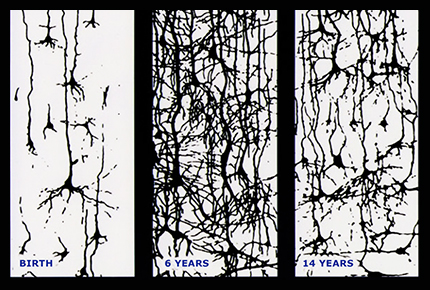Test your knowledge
about early childhood development.
Can you tell which of the following statements
are true and which are false?
Children truly begin to learn when they enter school.
FALSE
Children begin to learn much earlier than we think. They do so by observing and imitating us and through play. Obviously, they learn many things in the classroom: reading, writing, counting, etc. The knowledge they acquire in school will be useful throughout their lives. However, children begin to lay the foundations of the adults they will grow up to become well before they enter school.
Intense brain activity
Even a fetus and a new-born already learn things! Children’s brain activity is at its peak just before birth and retains its intensity during the first three years of life. During this period, a child’s capacity for learning is at its most pronounced.

Source originale:Conel, JL. The postnatal development of the human cerebral cortex. Cambridge, Mass: Harvard University Press, 1959.
This period is so intense that no machine, not even the Internet, can match a baby’s capacity for learning. With more than one million new neural connections per second, the brains of newborns and toddlers can learn a great deal very quickly!
It is one of the reasons babies sleep a lot: They work very hard while awake, and during sleep, their brain pieces together the different parts of the confusing world that surrounds them. As such, if they are expected to be able to hold a pen and write one day, children must first experience tossing food on the floor, playing with building blocks, throwing a ball, and scribbling on walls.
Further information:
Taking action during the early years Development Action
Observatoire des tout-petits infographic: Les enfants ont-ils tous des chances égales à leur entrée à l'école? [Do all children have the same chances available to them when they enter school?] [In French only]
Early childhood development initiatives are a smart investment.
TRUE
Making a decision to spend money on early childhood development can prove difficult. Given the pressing problems we face in relation to poverty, high-school dropout rates, health issues, crime, caring for the elderly, etc., investing in our young children doesn’t seem like the most obvious choice. However, a whole slew of future problems could be prevented if only we devoted more attention and funding to early childhood development. After all, isn’t prevention better than cure?
Preventive measures: a small cost to pay
Economist and Nobel Prize laureate James Heckman has taken a closer look at the costs of prevention and compared them to the resources required for stop-gap measures down the line. His findings are very clear: Not only do the period of pregnancy and the first years in a child’s life constitute the best time for action and prevention, but any investments undertaken during this period are also the least costly. The later any potential interventions take place, the more expensive, time-consuming and intensive they become and the poorer the outcomes. In other words, investing in early childhood development isn’t very expensive, and it produces results!

Source: Early Childhood development is a smart investment, James Heckman, Nobel Prize laureate in Economic Sciences
A smart choice that benefits society
A decision to invest in young children’s development isn’t just a smart choice in and of itself; it also puts more money back into the Québec government’s coffers! Studies carried out in the US1,2,3have shown that every dollar spent on young children produces an average return of between $4 an $9. Québec’s public daycares alone provide a return of between $2 and $3 for every dollar spent and enable many families to return to the job market or pursue their studies.
Investing in early childhood development is very cost-effective. One thing is for certain: The investments we fail to make today will need to be paid for later on. Québec’s high-school dropout rate on its own costs taxpayers close to $2 billion every year. Rather than question whether our society has the means to fund early childhood development projects, we should be asking whether Québec society can afford not to invest in our young children.
Different forms of investment
One interesting fact to note is that an investment in early childhood education does not necessarily imply a need for extra funding. While some early childhood projects do require additional budget allocations, many other initiatives and projects can materialize as the result of collaborations between different actors, involving, for example, a community-based agency, school, daycare, municipality, or CLSC. In many cases, several solutions may already be within reach but could be further enhanced through expert input from a range of different stakeholders. This should include giving a greater say to parents and children, who are the first to benefit from the projects and activities being set up in their community.
Further information:
Observatoire des tout-petits infographic: Les enfants ont-ils tous des chances égales à leur entrée à l'école?[Do all children have the same chances available to them when they enter school?] [in French only]
1. Masse, L. and Barnett, W.S.,(2002). A Benefit Cost Analysis of the Abecedarian Early Childhood Intervention.
2. Karoly et al. (2005). Early Childhood Interventions: Proven Results, Future Promise.
3. Heckman, J.J., Moon, S. H., et al. (2010). The rate of return to the HighScope Perry Preschool Program. Journal of public Economics, 94(1), 114-128.
The education of young children is, first and foremost, a matter for their parents.
TRUE AND FALSE
Parents, childcare practitioners and researchers are in broad agreement that parents are their children’s primary educators. Parents are the most significant individuals in the lives of children and will have the greatest impact on their development.
However, parents can’t possibly show their children everything, and their parenting role isn’t always easy. They too occasionally need a break, support or encouragement.
The importance of the child’s human environment

The community mobilized into action
Young children’s well-being is a concern for the entire community, as they represent its most valuable asset. Today’s children will be tomorrow’s citizens, leaders, doctors, mechanics, firefighters and teachers. Whether it is the municipality implementing child-friendly actions, the business community deciding to introduce family-work balance measures or get involved in community-based child development projects, community agencies serving a large number of families, or the CLSC providing healthcare and social services to children and their parents—they all contribute to the well-being of the young children in the community.
Further information:
Collaborer avec la municipalité pour la qualité de vie des familles et des tout-petits [in French only]
Illustrations de démarches de collaboration inspirantes entre les partenaires de la petite enfance et du milieu municipal [in French only]
Collaborer avec les parents [in French only]
L'importance d'un réseau social pour les parents [in French only]
Public interest campaingn L’importance de l’entourage [in French only]
Children develop reading skills well before they enter school.
TRUE
Books are invaluable toys, even for babies!
Even though young children may drool on them or tear the pages, the more familiar they become with books, the more likely they are to develop a taste for handling and using them when they grow up. Books are toys that encourage children to use their imagination, to think and figure out the surrounding world. By identifying with the characters in a book, children gain a better understanding of their thoughts and feelings. Book-centred activities are also enjoyable family moments that help foster children’s language development.
Early reading activities
Early reading activities enable children to learn a more varied vocabulary, which has beneficial effects on their future. By the age of five, children that grew up in environments where people spoke very little or there weren’t any books will have been exposed to 30 million fewer words, on average, than other children. Imagine the huge gap these children will have to bridge when they start kindergarten!
Once a child has grown up to become an adult, reading skills aren’t only useful for reading novels. These skills also constitute a useful communication tool for reading the newspaper, following the news, cooking from a recipe, understanding a doctor’s prescription, or replying to a note received from your child’s school—in short, reading skills help to guarantee that you can function normally within society.
More than one in two Quebecers do not have adequate reading skills for managing the requirements of everyday life. Exposing very young children to books is a way of tackling this major social problem head-on.
Further information:
«Protective factor : Oral and written communication skills
Le livre, le meilleur jouet des tout-petits, Naître et grandir resource [in French only]
Langage, développement social et apprentissage, Naître et grandir resource [in French only]
L’éveil à la lecture et à l’écriture, Éducatout.com [in French only]
It isn’t important to speak to babies when they are not yet able to talk.
FALSE
Language development kicks into action during pregnancy!
Contrary to popular belief, babies learn to speak before they utter their first words! The fetus inside a mother’s belly can already perceive sounds: the mother’s heartbeat, the mother’s and father’s voices, certain songs, etc.
As surprising as that may seem, the areas in the brain responsible for language development become active starting at six and a half months into the pregnancy. The peak period of a child’s language development occurs between the final stages of pregnancy and approximately 18 months.
Language development disparities are observable very early on. By the age of 18 months, children who were frequently spoken, sung or read to when they were still very young, dispose of, on average, over 600 vocabulary words more than their peers who weren’t spoken to very much.
Further information:
Protective factor : Oral and written communication skills
Windows of opportunity
Observatoire des tout-petits infographic: Développement cognitif et langagier [in French only]
Les données de l’Observatoire des tout-petits [in French only]


